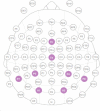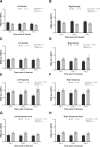Surgical stress: the muscle and cognitive demands of robotic and laparoscopic surgery
- PMID: 37342254
- PMCID: PMC7614670
- DOI: 10.1097/AS9.0000000000000284
Surgical stress: the muscle and cognitive demands of robotic and laparoscopic surgery
Abstract
Introduction: Surgeons are among the most at-risk professionals for work-related musculoskeletal decline and experience high mental demands. This study examined the electromyographic (EMG) and electroencephalographic (EEG) activities of surgeons during surgery.
Methods: Surgeons who performed live laparoscopic (LS) and robotic (RS) surgeries underwent EMG and EEG measurements. Wireless EMG was used to measure muscle activation in four muscle groups bilaterally (biceps brachii, deltoid, upper trapezius, and latissimus dorsi), and an 8-channel wireless EEG device was used to measure cognitive demand. EMG and EEG recordings were completed simultaneously during (i) noncritical bowel dissection, (ii) critical vessel dissection, and (iii) dissection after vessel control. Robust ANOVA was used to compare the %MVCRMS and alpha power between LS and RS.
Results: Thirteen male surgeons performed 26 laparoscopic surgeries (LS) and 28 robotic surgeries (RS). Muscle activation was significantly higher in the right deltoid (p = 0.006), upper trapezius (left, p = 0.041; right, p = 0.032), and latissimus dorsi (left, p = 0.003; right, p = 0.014) muscles in the LS group. There was greater muscle activation in the right biceps than in the left biceps in both surgical modalities (both p = 0.0001). There was a significant effect of the time of surgery on the EEG activity (p <0.0001). A significantly greater cognitive demand was observed in the RS than in the LS with alpha, beta, theta, delta, and gamma (p = 0.002 - p <0.0001).
Conclusion: These data suggest greater muscle demands in laparoscopic surgery, but greater cognitive demands in robotic surgery.
Keywords: Electroencephalography; Electromyography; Laparoscopic surgery; Minimally invasive surgery; Robotic surgery.
Conflict of interest statement
AS, DAS, HEN, TB, and CG received a clinical research grant from the Intuitive Foundation (A105089), which funded this work. KS and HEN are supported by BBSRC (BB/S008527/1). MW, MA-A, IC, NH, LV, AS, MG, & BZ declare that they do not have any conflicts of interest. This trial was registered at Clinicaltrials.gov (NCT04477746). Conflict of interest This work was funded by a clinical research grant from the Intuitive Foundation. The funder had no role in the study design, its execution, analyses, interpretation of the data, or decision to submit the results.
Figures




References
-
- Rassweiler J, Rassweiler MC, Kenngott H, et al. . The past, present and future of minimally invasive therapy in urology: a review and speculative outlook. Minim Invasive Ther Allied Technol. 2013;22:200–209. - PubMed
-
- Scarpa M, Cavallin F, Saadeh L, et al. . Hybrid minimally invasive esophagectomy for cancer: impact on postoperative inflammatory and nutritional status. Dis Esophagus. 2016;29:1064–1070. - PubMed
-
- van der Pas MH, Haglind E, Cuesta MA, et al. ; COlorectal cancer Laparoscopic or Open Resection II (COLOR II) Study Group. Laparoscopic versus open surgery for rectal cancer (COLOR II): short-term outcomes of a randomised, phase 3 trial. Lancet Oncol. 2013;14:210–218. - PubMed
-
- Fu Y, Pan B, Li K, et al., eds. Laparoscopic robot design and kinematic validation. 2006 IEEE International Conference on Robotics and Biomimetics. IEEE; 2006.
Grants and funding
LinkOut - more resources
Full Text Sources

